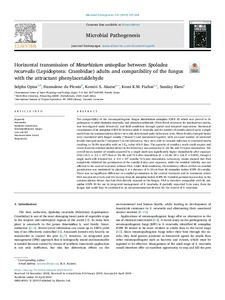| dc.contributor.author | Opisa, S. |
| dc.contributor.author | Plessis, H. du |
| dc.contributor.author | Akutse, K.S. |
| dc.contributor.author | Fiaboe, K.M. |
| dc.contributor.author | Ekesi, S. |
| dc.date.accessioned | 2019-12-04T11:33:13Z |
| dc.date.available | 2019-12-04T11:33:13Z |
| dc.date.issued | 2019-06 |
| dc.identifier.citation | Opisa, S., du Plessis, H., Akutse, K.S., Fiaboe, K.M. & Ekesi, S. (2019). Horizontal transmission of Metarhizium anisopliae between Spoladea recurvalis (Lepidoptera: Crambidae) adults and compatibility of the fungus with the attractant phenylacetaldehyde. Microbial Pathogenesis, 131, 197-204. |
| dc.identifier.issn | 0882-4010 |
| dc.identifier.uri | https://hdl.handle.net/20.500.12478/5564 |
| dc.description | Published online: 10 April 2019 |
| dc.description.abstract | The compatibility of the entomopathogenic fungus Metarhizium anisopliae ICIPE 30 which was proved to be pathogenic to adult Spoladea recurvalis, and phenylacetaldehyde (PAA) floral attractant for lepidopteran moths, was investigated under laboratory and field conditions through spatial and temporal separations. Horizontal transmission of M. anisopliae ICIPE 30 between adult S. recurvalis and the number of conidia picked up by a single moth from the autoinoculation device were also determined under laboratory tests. When freshly emerged moths were inoculated with fungal conidia (“donors”) and maintained together with an equal number of untreated freshly emerged moths (“recipients”) in the laboratory, they were able to transmit infection to untreated moths resulting to 76.9% mortality with an LT50 value of 6.9 days. The quantity of conidia a moth could acquire and retain from the autoinoculation device in the laboratory was assessed at 0, 24, 48, and 72 h post-inoculation. The overall mean number of conidia acquired by a single moth was significantly higher immediately after exposure (0 h) (14.3 ± 2.5 × 105) than at 24, 48, and 72 h after inoculation (F = 10.26, Df = 3,8, P = 0.003), though a single moth still retained 4.6 ± 0.9 × 105 conidia 72 h post inoculation. Laboratory results showed that PAA completely inhibited the germination of the conidia 8 days post exposure, while the conidial viability was not affected in the control treatment without PAA. Under field conditions, the inhibitory effects of PAA on conidial germination was minimized by placing it at a distance of 5–10 cm from M. anisopliae isolate ICIPE 30 conidia. There was no significant difference in conidial germination in the control treatment and in treatments where PAA was placed at 5 cm and 10 cm away from M. anisopliae isolate ICIPE 30. Conidial germination was low in the autoinoculation device that had PAA directly exposed to the fungus. PAA is therefore compatible with M. anisopliae ICIPE 30 for use in integrated management of S. recurvalis, if spatially separated 5 cm away from the fungus and could thus be combined in an autocontamination devices for the control of S. recurvalis. |
| dc.description.sponsorship | Federal Ministry for Economic Cooperation and Development, Germany |
| dc.format.extent | 197-204 |
| dc.language.iso | en |
| dc.rights | Copyrighted; all rights reserved |
| dc.subject | Biopesticides |
| dc.subject | Metarhizium Anisopliae |
| dc.subject | Plant Diseases |
| dc.subject | Kenya |
| dc.subject | Disease Control |
| dc.title | Horizontal transmission of Metarhizium anisopliae between Spoladea recurvalis (Lepidoptera: Crambidae) adults and compatibility of the fungus with the attractant phenylacetaldehyde |
| dc.type | Journal Article |
| dc.description.version | Peer Review |
| cg.contributor.affiliation | International Centre of Insect Physiology and Ecology |
| cg.contributor.affiliation | North-West University |
| cg.contributor.affiliation | International Institute of Tropical Agriculture |
| cg.coverage.region | Africa |
| cg.coverage.region | East Africa |
| cg.coverage.country | Kenya |
| cg.isijournal | ISI Journal |
| cg.authorship.types | CGIAR and developing country institute |
| cg.iitasubject | Disease Control |
| cg.iitasubject | Plant Diseases |
| cg.journal | Microbial Pathogenesis |
| cg.howpublished | Formally Published |
| cg.accessibilitystatus | Limited Access |
| local.dspaceid | 104777 |
| cg.targetaudience | Scientists |
| cg.identifier.doi | https://dx.doi.org/10.1016/j.micpath.2019.04.010 |

